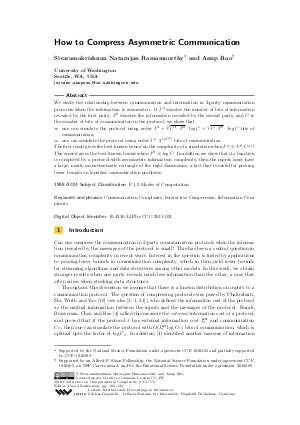How to Compress Asymmetric Communication
Authors Sivaramakrishnan Natarajan Ramamoorthy, Anup Rao
-
Part of:
Volume:
30th Conference on Computational Complexity (CCC 2015)
Part of: Series: Leibniz International Proceedings in Informatics (LIPIcs)
Part of: Conference: Computational Complexity Conference (CCC) - License:
 Creative Commons Attribution 3.0 Unported license
Creative Commons Attribution 3.0 Unported license
- Publication Date: 2015-06-06
File

PDF
LIPIcs.CCC.2015.102.pdf
- Filesize: 0.54 MB
- 22 pages
Document Identifiers
Subject Classification
Keywords
- Communication Complexity
- Interactive Compression
- Information Complexity
Metrics
- Access Statistics
-
Total Accesses (updated on a weekly basis)
0PDF Downloads0Metadata Views
Abstract
We study the relationship between communication and information in 2-party communication protocols when the information is asymmetric. If I^A denotes the number of bits of information revealed by the first party, I^B denotes the information revealed by the second party, and C is the number of bits of communication in the protocol, we show that i) one can simulate the protocol using order I^A + (C^3 * I^B)^(1/4) * log(C) + (C * I^B)^(1/2) * log(C) bits of communication, ii) one can simulate the protocol using order I^A * 2^(O(I^B)) bits of communication The first result gives the best known bound on the complexity of a simulation when I^A >> I^B,C^(3/4). The second gives the best known bound when I^B << log C. In addition we show that if a function is computed by a protocol with asymmetric information complexity, then the inputs must have a large, nearly monochromatic rectangle of the right dimensions, a fact that is useful for proving lower bounds on lopsided communication problems.
Cite As Get BibTex
Sivaramakrishnan Natarajan Ramamoorthy and Anup Rao. How to Compress Asymmetric Communication. In 30th Conference on Computational Complexity (CCC 2015). Leibniz International Proceedings in Informatics (LIPIcs), Volume 33, pp. 102-123, Schloss Dagstuhl – Leibniz-Zentrum für Informatik (2015)
https://doi.org/10.4230/LIPIcs.CCC.2015.102
BibTex
@InProceedings{natarajanramamoorthy_et_al:LIPIcs.CCC.2015.102,
author = {Natarajan Ramamoorthy, Sivaramakrishnan and Rao, Anup},
title = {{How to Compress Asymmetric Communication}},
booktitle = {30th Conference on Computational Complexity (CCC 2015)},
pages = {102--123},
series = {Leibniz International Proceedings in Informatics (LIPIcs)},
ISBN = {978-3-939897-81-1},
ISSN = {1868-8969},
year = {2015},
volume = {33},
editor = {Zuckerman, David},
publisher = {Schloss Dagstuhl -- Leibniz-Zentrum f{\"u}r Informatik},
address = {Dagstuhl, Germany},
URL = {https://drops.dagstuhl.de/entities/document/10.4230/LIPIcs.CCC.2015.102},
URN = {urn:nbn:de:0030-drops-50679},
doi = {10.4230/LIPIcs.CCC.2015.102},
annote = {Keywords: Communication Complexity, Interactive Compression, Information Complexity}
}
Author Details
References
-
Farid Ablayev. Lower bounds for one-way probabilistic communication complexity. In Andrzej Lingas, Rolf Karlsson, and Svante Carlsson, editors, Proceedings of the 20th International Colloquium on Automata, Languages, and Programming, volume 700 of LNCS, pages 241-252. Springer-Verlag, 1993.

-
Alexandr Andoni, Piotr Indyk, and Mihai Pǎtraşcu. On the optimality of the dimensionality reduction method. In Proc. 47th IEEE Symposium on Foundations of Computer Science (FOCS), pages 449-458, 2006.

-
Reuven Bar-Yehuda, Benny Chor, Eyal Kushilevitz, and Alon Orlitsky. Privacy, additional information and communication. IEEE Transactions on Information Theory, 39(6):1930-1943, 1993. Preliminary version in CCC'90.

-
Boaz Barak, Mark Braverman, Xi Chen, and Anup Rao. How to compress interactive communication. In Proceedings of the 2010 ACM International Symposium on Theory of Computing, pages 67-76, 2010.

-
Allan Borodin, Rafail Ostrovsky, and Yuval Rabani. Lower bounds for high dimensional nearest neighbor search and related problems. In Proceedings of the Thirty-First Annual ACM Symposium on Theory of Computing (STOC'99), pages 312-321, New York, May 1999. Association for Computing Machinery.

-
Mark Braverman. Interactive information complexity. Electronic Colloquium on Computational Complexity (ECCC), 18:123, 2011.

-
Mark Braverman. Interactive information complexity. In Proceedings of the 44th symposium on Theory of Computing, STOC'12, pages 505-524, New York, NY, USA, 2012. ACM.

-
Mark Braverman and Anup Rao. Information equals amortized communication. In Rafail Ostrovsky, editor, FOCS, pages 748-757. IEEE, 2011.

-
Mark Braverman and Omri Weinstein. A discrepancy lower bound for information complexity. CoRR, abs/1112.2000, 2011.

-
Amit Chakrabarti, Yaoyun Shi, Anthony Wirth, and Andrew Yao. Informational complexity and the direct sum problem for simultaneous message complexity. In Proceedings of the 42nd Annual IEEE Symposium on Foundations of Computer Science, pages 270-278, 2001.

-
Anat Ganor, Gillat Kol, and Ran Raz. Exponential separation of information and communication for boolean functions. Electronic Colloquium on Computational Complexity (ECCC), 21:113, 2014.

-
T. S. Jayram, Subhash Khot, Ravi Kumar, and Yuval Rabani. Cell-probe lower bounds for the partial match problem. J. Comput. Syst. Sci, 69(3):435-447, 2004.

-
Iordanis Kerenidis, Sophie Laplante, Virginie Lerays, Jérémie Roland, and David Xiao. Lower bounds on information complexity via zero-communication protocols and applications. Electronic Colloquium on Computational Complexity (ECCC), 19:38, 2012.

-
Eyal Kushilevitz and Noam Nisan. Communication complexity. Cambridge University Press, Cambridge, 1997.

-
Peter Miltersen, Noam Nisan, Shmuel Safra, and Avi Wigderson. On data structures and asymmetric communication complexity. Journal of Computer and System Sciences, 57:37-49, 1 1998.

-
Peter Bro Miltersen. Lower bounds for union-split-find related problems on random access machines. In Proceedings of the 26th Annual Symposium on the Theory of Computing, pages 625-634, New York, May 1994. ACM Press.

-
Peter Bro Miltersen. Cell probe complexity - a survey. In V. Raman, C. Pandu Rangan, and R. Ramanujam, editors, Proceedings of the 19th Conference on Foundations of Software Technology and Theoretical Computer Science, Chennai, India, December 13-15, 1999, volume 1738 of Lecture Notes in Computer Science. Springer-Verlag, 1999.

-
Mihai Pǎtraşcu. Unifying the landscape of cell-probe lower bounds. SIAM Journal on Computing, 40(3):827-847, 2011. See also FOCS'08, arXiv:1010.3783.

-
Mihai Pǎtraşcu and Mikkel Thorup. Higher lower bounds for near-neighbor and further rich problems. SIAM Journal on Computing, 39(2):730-741, 2010. See also FOCS'06.

-
Mert Saglam. Private communication, 2014.

-
Michael Saks and Xiaodong Sun. Space lower bounds for distance approximation in the data stream model. In ACM, editor, Proceedings of the 34th Annual ACM Symposium on Theory of Computing, pages 360-369. ACM Press, 2002.

